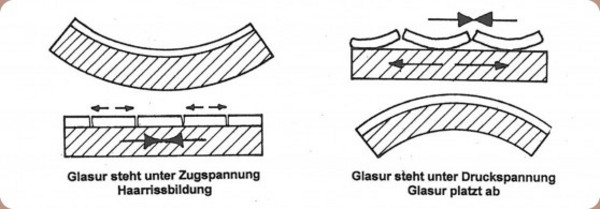Pottery Know-How / FAQ
When is a piece of ceramic frost resistant?
Whenever a fired piece of ceramic is to be put outside then it is needs to be frost resistant. If water can be absorbed by the piece, then the water will expand when it freezes which can cause the piece to crack or break. That is why it is necessary that the piece is fired until the surface is non-porous, which means - not able to absorb water. The absorption should be less than 2 %.
How can the water absorption be tested?
A fired, dry and unglazed test piece, at least 5 cm x 5 cm, is weighed. Then it is put in a cooking pot and completely covered by water. The water is then brought to the boil. Thereafter, it is left to soak for 24 hours. After which, it is removed and the drops of water on the test piece are wiped away with a sponge. The test piece is then weighed again. The difference in weight is the water absorption. This value in relation to its dry weight is a percentage, e.g. 48.5 g dry, 49 g wet is an absorption of 0.5 g, divided into 48.5 g and multiplied by 100 g, results in 1.0 % water absorption.
Technical instructions: Drying- and firing shrinkage
Technical instructions: Drying- and firing shrinkage
Technical instructions: Deflocculation of a porcelain body
Technical instructions: Deflocculation of a porcelain body
Technical instructions: Thermal shock resistance
Technical instructions: Thermal shock resistance
At what temperature does my clay body become non-porous?
Each body has a certain firing range. During the firing the ceramic becomes less and less porous with increasing temperatures. Ceramic is classed as non-porous when it absorbs less than 2% water. The porosity can be tested with the previously mentioned water absorption test.
How long can I store Goerg & Schneider-bodies?
The Goerg & Schneider bodies can be stored for up to 1 year in the original undamaged packaging. To achieve this, they should be stored in dark, cool and frost free conditions - ideally + 5 °C to + 18 °C.
The red and black bodies have hardened, what can I do?
The coloured bodies tend to harden faster with time however, if you knead them thoroughly, they will regain their original consistency.
Why does the body become mouldy and what effect does this have on the quality?
Clay is a product of nature which naturally contains organic matter. In damp conditions and in plastic bags, the natural organic component of the body begins to rot and as a result mould / algae forms. This is known as aging and actually improves the plasticity of the clay. Bodies that rot and form mould or algae are clays of high quality and very plastic. If your clay is mouldy or has algae, simply knead the clay well before using it.
What happens if the CTE of the fired body and glaze is different?

If a glaze is melted on a ceramic piece with a greater expansion than the fired body, it contracts more during the cooling down than the fired body. Consequently, the glaze comes under stress. If the fired body is very thin, the glaze could concave warp the fired body. In most cases the fired body is strong enough to allow the tension in the glaze to be released through cracking. This is the cause of the so-called hair cracks.
Conversely, if the glaze expands less than the fired body, it contracts less than the fired body when cooled. As a result, the glaze comes under compressive stress and can be pressed together so much that it lifts and flakes off. This happens especially on the edges and borders of ceramic pieces. If the fired body is very thin, it can concave warp.
In practise it is desirable that the glaze is under slight compressive stress.



